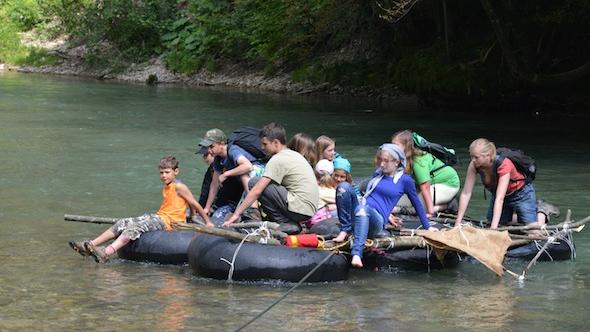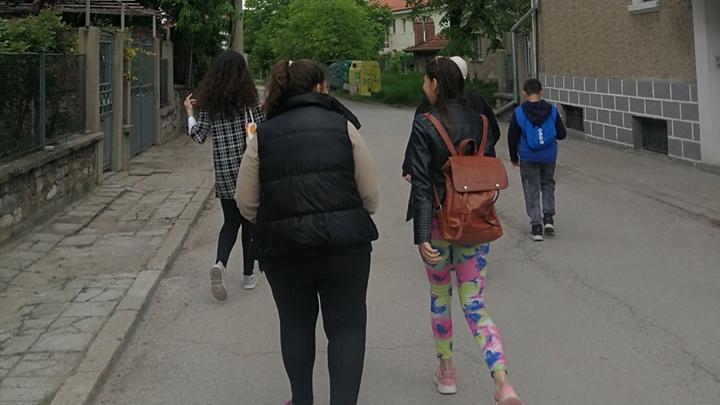Building rafts and navigating rivers and lakes is considered by many to be a dream outdoor experience and is associated with exciting stories such as Tom Sawyer. This article will discuss different types of raft building, as well as how to implement them in Jungschar work.
Buoyancy body
Fundamentally, the question of the buoyancy body is closely related to the type of use of the raft. A raft is not properly usable until the construct floats and even with loading from one or more people the top edge of the raft is not under water. Thus it becomes clear that for every kilogram that is to be above the water's surface, the buoyancy body in the water must provide a certain amount of water displacement. Simply said: Everything floats that is lighter than 1 kg per one volume litre (=1 dm3). The lower the weight of the buoyancy body per volume litre, the more buoyancy there is and the raft can be loaded more with the same size. In other words, a raft for 4 people built purely of wood has a remarkably larger mass and correspondingly greater weight (approx. 1 ton) because of the poor buoyancy of the wood. On the other hand, a raft built with buoyancy can be made portable for 4 persons. The following materials are basically suitable for use as buoyancy in Jungschar everyday life:
- Wood
- Truck hatches
- Bins (plastic or metal)
- Sagex
- PET, or similar
The fact is that the romantic solid wood boat is unsuitable for trips on our rivers and lakes because of the weight and therefore inertia. However, for a fixed raft on the lake, wood consistently provides what is necessary for a cool swimming platform. It is recommended to have two thick logs as main buoyancy bodies and thinner logs above them as platform and buoyancy bodies, connected with cross- resp. cross-braces. The main buoyancy bodies should be connected crosswise with other logs, so that the raft is laterally stable. Important: The raft must be built so large that it is not brought to tilt by human weight.
Use of the raft
As already mentioned, the question of how the raft is to be used must first be clarified. Already with a very simple and not really stable raft can be crossed at a river, i.e. the raft is pulled from one side to the other, e.g. on the occasion of a hike. For children this can be an impressive experience. Other possibilities are:
- Fix at a lake
- Tours at the lake
- Tours on the river
Raft with truck hoses
The raft with truck hoses is great for crossing and touring on the river.
Advantages:
- Hoses may be available in the mat
- Easy to inflate, small for storage
- enormous buoyancy thanks to air
- Rugged tubes can also rub over rocks; tubes give way while other fins would squat up
- tied together tubes are already relatively stable, construction is possible purely with pioneering techniques
Disadvantages:
- Very large resistance in water - practically unsuitable for locomotion by rowing
- Air in tubes gives a lot of buoyancy, but the tubes cannot be tied together compactly enough and have a "hole" in the middle.
Construction
Depending on the size of the raft, 4 tubes, i.e. 2 on 2 (for a translation boat 3 on 3), or 2 on 3 or even more are tied tightly together with straw string or similar.
Using pioneer construction techniques, branch by branch is placed over the tubes and tied together. (net structure) or: A scaffold is screwed together from double laths and shuttering boards and then tied to the hoses with straw string.
River rafting
Safety
In Switzerland, rafting on rivers with children is only allowed when accompanied by experienced leaders with J&S safety module water activities and the corresponding SLRG training (module river).
Lake rafting is considered a normal water activity (SLRG Lake Module).
Rafting on rivers in principle requires leaders with SLRG training with module River.
Raft trips with children should be conducted exclusively by experienced leaders. Clear knowledge of the river etc. is necessary. The guidelines of SLRG and J&S apply!
Legal (2.5 m rule)
Rafting is also legally restricted. In Switzerland, this varies from canton to canton except for some basics. In some cantons, raft trips go beyond the normal permitted public use of the rivers and are considered a so-called nautical event (eg TG) and must therefore be approved by the authorities (permission from the municipality for watering and launching, raft is accepted by police before use, event insurance must be concluded, etc.)
But rafts are only floatable constructions from a size of 2.5m. Fins that are smaller therefore theoretically do not require a permit. On the other hand, on lakes with rafts of this size, the shore area may not be left for 150m, which is not recommended anyway.
More information
Further information on water activities under Y+S and SLRG, can be found in the article "Planning a Water Activity".
Source reference
Title image: Provided by Jungschar Stami St. Gallen
Content may be automatically translated. Help improve the quality of the translation with your editing!



